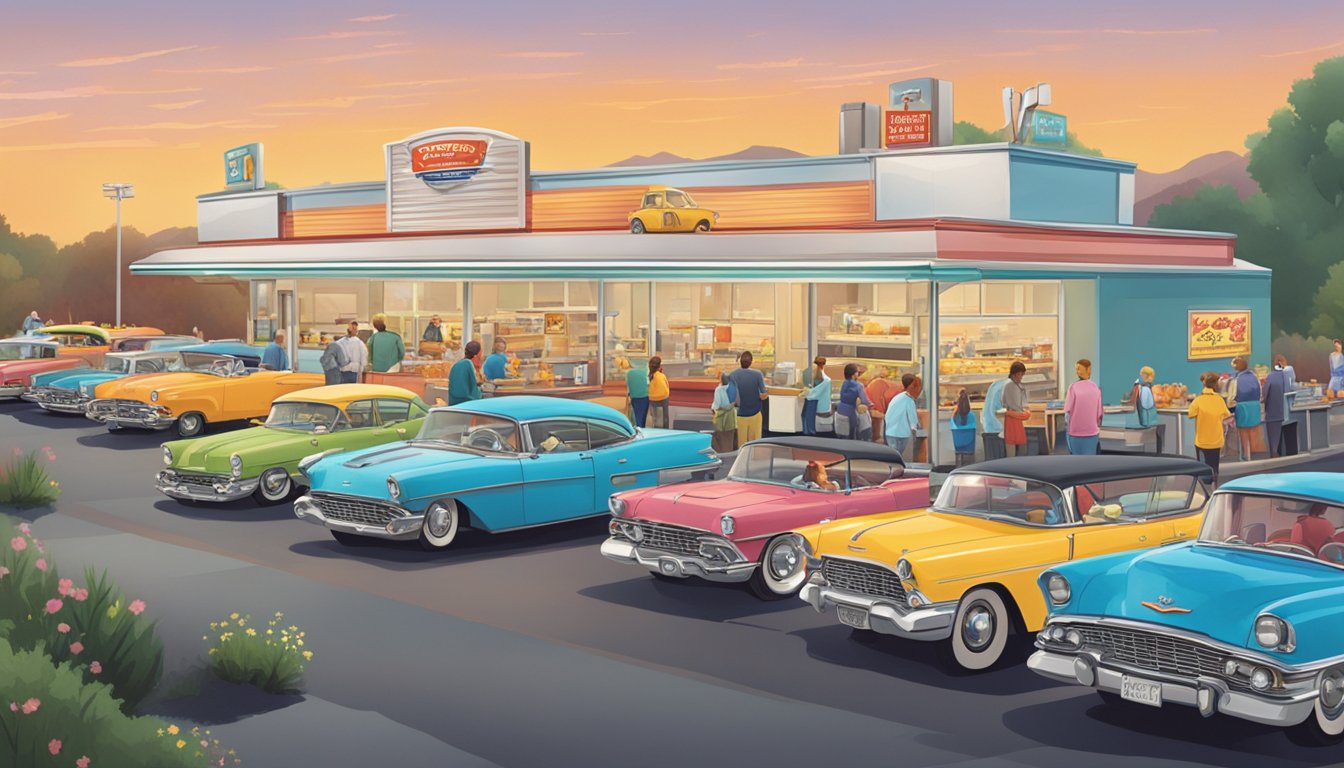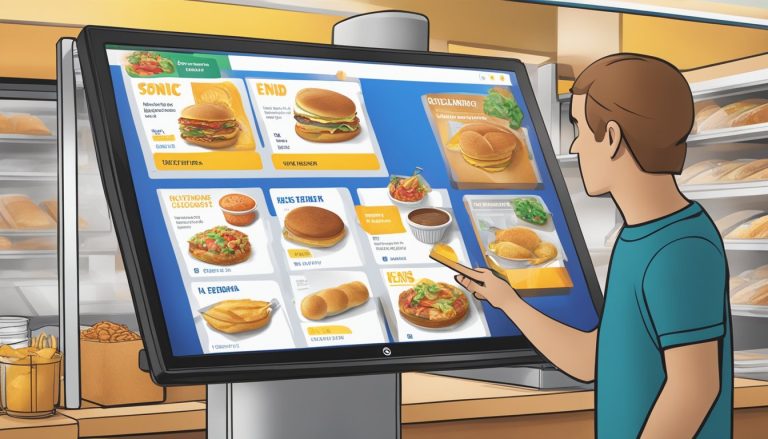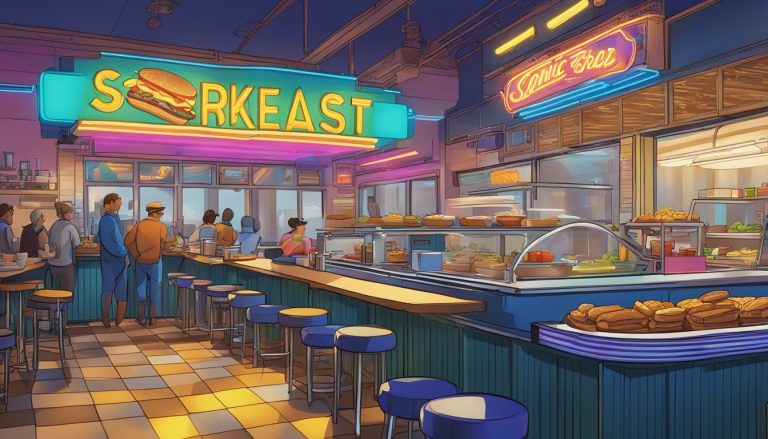Sonic Drive-In has transformed the fast-food breakfast landscape with its innovative drive-in model. This unique approach allows customers to enjoy their morning meals from the comfort of their vehicles, served by carhops who sometimes deliver on roller skates. The drive-in concept has proven particularly successful for Sonic’s breakfast service, offering a convenient and nostalgic dining experience that sets it apart from competitors.
The chain’s breakfast menu features a wide variety of options, from traditional favorites to creative offerings that cater to diverse tastes. Sonic’s ability to adapt to changing consumer preferences while maintaining its classic drive-in format has contributed to its enduring popularity. This flexibility was especially evident during the COVID-19 pandemic, when the company saw a significant increase in revenue.
Sonic’s success in the breakfast market demonstrates the power of combining a unique dining experience with a diverse menu. By embracing its retro roots while continuously innovating, Sonic has carved out a distinct niche in the competitive fast-food breakfast sector. The drive-in model not only provides convenience but also adds an element of fun and nostalgia to the morning routine, making Sonic a go-to choice for many breakfast enthusiasts.
The History of Sonic Drive-In
Sonic Drive-In’s journey from a small root beer stand to a nationwide fast-food chain reflects American entrepreneurship and innovation in the restaurant industry. The company’s unique drive-in format and focus on customization set it apart from competitors.
The Founding by Troy Smith
Troy N. Smith Sr. opened the first Sonic location in 1953 in Shawnee, Oklahoma. Initially called Top Hat Drive-In, the restaurant started as a walk-up root beer stand. Smith’s entrepreneurial spirit led him to install an intercom system for ordering, a novel concept at the time. This innovation allowed customers to place orders without leaving their cars, enhancing convenience and speed of service.
In 1959, Smith and his business partner Charlie Pappe renamed the restaurant Sonic, inspired by their slogan “Service at the Speed of Sound.” The new name reflected the company’s commitment to quick, efficient service.
Drive-In Format Evolution
Sonic’s drive-in format revolutionized the fast-food experience. Customers could park in covered stalls, place orders via intercom, and have food delivered by carhops – often on roller skates. This nostalgic yet efficient model became Sonic’s trademark.
The company expanded through franchising in the 1960s and 1970s. Sonic’s unique format appealed to franchisees and customers alike, fueling rapid growth. By the 1970s, Sonic began modernizing its branding, introducing a new logo and updated marketing materials.
Sonic’s expansion continued steadily, with the chain reaching 1,000 locations by 1988. The company maintained its commitment to the drive-in format while adapting to changing consumer preferences, introducing new menu items and technology to enhance the ordering process.
The Drive-In Service Model

Sonic’s drive-in service model combines nostalgic charm with modern convenience. This innovative approach features carhops delivering food directly to customers’ vehicles and intercom systems for efficient ordering.
Unique Carhop Service
Sonic’s carhops are the heart of its drive-in experience. These friendly staff members bring orders directly to parked cars, often on roller skates. This retro-inspired service creates a fun, memorable atmosphere for diners.
Carhops wear distinctive uniforms, adding to the vintage feel. They’re trained to provide quick, courteous service, enhancing customer satisfaction. The use of roller skates isn’t mandatory but adds flair to the experience.
This personal touch sets Sonic apart from traditional drive-thrus. Customers can relax in their vehicles while enjoying freshly prepared meals. The carhop service also allows for easy customization of orders and prompt addressing of any issues.
Intercom Systems and Orders
Sonic’s intercom system streamlines the ordering process. Each parking stall features a menu board with a built-in intercom. Customers press a button to place their order, speaking directly to kitchen staff.
This system offers several advantages:
- Reduced wait times
- Improved order accuracy
- Personalized service
The intercom allows customers to ask questions about menu items or make special requests. It also enables staff to confirm orders, ensuring accuracy.
After ordering, customers can pay at their stall or upon delivery. This flexibility adds to the convenience of the drive-in model. The intercom system, combined with carhop service, creates a unique dining experience that blends efficiency with nostalgia.
Breakfast Menu Innovation
Sonic Drive-In transformed the fast-food breakfast landscape through creative menu offerings and all-day availability. The chain’s innovations catered to diverse tastes and schedules, setting new industry standards.
Inception of the Breakfast Burrito
Sonic pioneered the breakfast burrito concept in the fast-food sector. The SuperSONIC Breakfast Burrito became a signature item, packed with sausage, eggs, tater tots, cheese, tomatoes, onions, and jalapeños. This hearty option offered customers a portable, filling meal.
The burrito’s success sparked a trend, inspiring other chains to create similar offerings. Sonic continued to innovate, introducing variations like the Ultimate Meat & Cheese Breakfast Burrito.
Priced around $4.69 and containing 590 calories, the SuperSONIC Breakfast Burrito provided value and satisfaction to customers seeking a substantial morning meal.
Introduction of Texas Toast and French Toast Sticks
Sonic differentiated itself by using Texas toast for its breakfast sandwiches. This thick-cut bread provided a unique texture and flavor profile compared to traditional English muffins or biscuits.
The Breakfast Toaster sandwiches became a popular menu item, featuring eggs, cheese, and choice of meat on Texas toast. This innovation offered a heartier alternative to typical breakfast sandwiches.
French Toast Sticks added a sweet option to Sonic’s breakfast lineup. These portable, dippable treats appealed to customers looking for a quick, indulgent breakfast or snack.
Sonic’s commitment to menu innovation extended beyond these items, with the chain regularly introducing seasonal specials and limited-time offers to keep customers engaged and excited about their breakfast options.
Customization: The Sonic Signature

Sonic Drive-In stands out for its extensive customization options. The chain empowers customers to tailor their meals and drinks precisely to their tastes.
Customizable Menu Options
Sonic’s menu offers unparalleled flexibility. Customers can modify burgers, hot dogs, and sandwiches with a wide array of toppings and sauces. Breakfast items are available all day, allowing patrons to enjoy morning favorites at any time.
The restaurant’s “Add-Ons” feature lets diners enhance their meals with extra ingredients. Popular customizations include:
- Bacon on burgers or sandwiches
- Extra cheese varieties
- Jalapeños for added spice
- Onion rings as a side or topping
This level of personalization ensures that each order is uniquely crafted to the customer’s preferences.
Drink Combinations and Mobile App
Sonic’s beverage selection is a cornerstone of its customization strategy. The chain boasts over 1.3 million drink combinations, including slushes, sodas, and milkshakes.
Key features of Sonic’s drink customization:
- Mix-and-match flavor add-ins
- Choice of ice (crushed or cubed)
- Size options from small to Route 44
The Sonic mobile app enhances the customization experience. Users can:
- Save favorite orders for quick reordering
- Customize drinks and meals with ease
- Access exclusive deals and promotions
This digital platform streamlines the ordering process, making personalization more accessible and convenient for customers.
Sonic’s Marketing and Brand Consistency

Sonic Drive-In’s marketing strategy blends nostalgia with innovation to create a unique brand identity. The company’s advertising campaigns and core values have played a crucial role in maintaining brand consistency while adapting to changing consumer preferences.
Advertising Campaigns and Nostalgia
Sonic’s marketing efforts often tap into nostalgia for the classic American drive-in experience. The brand’s iconic roller-skating carhops feature prominently in advertisements, reminding customers of Sonic’s 1950s roots.
For nearly two decades, Sonic’s “Two Guys” campaign was a cornerstone of its advertising. The humorous ads featured two men bantering in a car about Sonic’s menu offerings, creating a relatable and memorable brand image.
In 2024, Sonic introduced a new brand platform called “Live Free Eat Sonic.” This campaign centers around a fictional “Department of Research and Deliciousment,” injecting fresh energy into the brand’s marketing while maintaining its playful tone.
Core Values and Rebranding Efforts
Sonic’s core values emphasize quality, service, and innovation. The company consistently updates its menu to offer new and exciting options while maintaining classic favorites.
In 2018, Sonic became part of Inspire Brands, joining other well-known restaurant chains. Despite this change in ownership, Sonic has maintained its distinct brand identity and unique drive-in model.
The company’s loyalty program, Sonic App, reinforces brand consistency by offering personalized deals and rewards to frequent customers. This digital initiative helps Sonic stay relevant in the modern fast-food landscape while preserving its nostalgic appeal.
Sonic’s rebranding efforts focus on balancing its heritage with contemporary trends. The brand continues to evolve its marketing strategies, ensuring it remains appealing to both long-time fans and new customers in a competitive fast-food market.
Growing the Franchise Network

Sonic Drive-In’s expansion strategy relies heavily on franchising to fuel rapid growth across the United States. This approach has allowed Sonic to become one of the largest drive-in restaurant chains in the country.
The Role of Franchising in Expansion
Sonic’s franchise model has been instrumental in its nationwide expansion. The company offers entrepreneurs the opportunity to open their own Sonic Drive-In locations, leveraging the brand’s established reputation and unique drive-in concept.
Franchisees benefit from Sonic’s proven business model, marketing support, and operational guidance. This strategy has enabled Sonic to expand into new markets quickly and efficiently.
As of 2025, Sonic boasts over 3,500 locations across 46 states. The franchise network continues to grow, with new Drive-Ins opening regularly in both existing and untapped markets.
Inspire Brands and Future Visions
In 2018, Sonic Corporation was acquired by Inspire Brands, a multi-brand restaurant company. This acquisition has opened up new avenues for growth and innovation within the Sonic franchise network.
Inspire Brands brings additional resources and expertise to support Sonic’s expansion efforts. The company is focused on modernizing Sonic’s operations and enhancing the customer experience.
Future plans include:
- Implementing advanced technology in Drive-In locations
- Exploring new store formats to suit diverse markets
- Expanding delivery and mobile ordering options
These initiatives aim to strengthen Sonic’s competitive position and attract new franchisees to further grow the brand’s presence across the United States.
Enhancing Customer Experience

Sonic Drive-In has implemented several strategies to improve customer satisfaction and loyalty. These efforts focus on offering attractive promotions and fostering a sense of community connection.
Happy Hour and Limited-Time Offers
Sonic’s Happy Hour promotion has become a key driver of customer traffic. From 2-4 PM daily, the restaurant offers half-price drinks and slushes. This promotion encourages visits during traditionally slower afternoon hours.
Sonic also frequently introduces limited-time menu items to generate excitement. Recent offerings have included the Pickle Juice Slush and Garlic Butter Bacon Burger. These unique items create buzz on social media and entice customers to visit.
The drive-in chain leverages technology to enhance the ordering experience. Sonic’s mobile app allows customers to customize orders, access exclusive deals, and pay directly through their phones.
Maintaining Customer Loyalty
Sonic focuses on building long-term relationships with customers through its rewards program. Members earn points on purchases that can be redeemed for free menu items. The program also provides personalized offers based on individual preferences and ordering history.
Community involvement plays a crucial role in Sonic’s customer loyalty efforts. The company supports local schools through its Limeades for Learning initiative. This program has donated over $19 million to public school teachers since 2009.
Sonic maintains consistency across its locations through standardized training programs. Carhops receive extensive instruction on customer service techniques to ensure a positive experience at every visit.
Nutritional Information Transparency

Sonic Drive-In provides detailed nutritional information for its menu items, allowing customers to make informed choices about their breakfast selections. This transparency covers key nutritional aspects, including calorie and fat content.
Calories and Fat Content Disclosure
Sonic’s breakfast menu offers a range of options with varying calorie and fat content. The Jr. Breakfast Burrito contains 270 calories and 14 grams of fat, making it a lighter choice for those watching their intake. On the higher end, items like the Bagel Breakfast Sandwich with bacon pack 530 calories and 19 grams of fat.
For health-conscious customers, Sonic’s nutrition guide categorizes menu items by calorie ranges. This system helps diners quickly identify lower-calorie breakfast options.
The chain’s website and in-store materials provide comprehensive nutritional data. This includes not only calories and fat but also cholesterol, sodium, and sugar content for each breakfast item.
Sonic’s commitment to transparency allows customers to tailor their breakfast choices to their dietary needs and preferences. Whether seeking a hearty meal or a lighter start to the day, patrons can easily access the information needed to make informed decisions.
Sonic’s Socio-Economic Impact

Sonic Drive-In has made significant contributions to local economies and communities across the United States. The company’s unique business model has fueled revenue growth and job creation while fostering community engagement through various corporate responsibility initiatives.
Revenue Growth and Job Creation
Sonic’s expansion has boosted local economies by generating substantial revenue and employment opportunities. As of 2025, the chain operates over 3,500 locations across 46 states, employing thousands of workers. The drive-in model has proven particularly resilient during economic downturns and public health crises, allowing Sonic to maintain operations and jobs when other restaurants struggled.
The company’s franchising approach has also empowered local entrepreneurs. Many Sonic locations are owned and operated by community members, creating a ripple effect of economic benefits. This model has led to increased tax revenues for municipalities and stimulated local business ecosystems.
Community Involvement and Corporate Responsibility
Sonic has established itself as a socially responsible corporate citizen through various community-focused initiatives. The Limeades for Learning program, launched in 2009, has donated millions of dollars to public school classrooms across the country. This initiative supports teachers and students by funding essential educational projects and resources.
The company also prioritizes environmental sustainability. Sonic has implemented energy-efficient practices in its restaurants, reducing carbon footprints and operational costs. Many locations have adopted LED lighting, energy-efficient kitchen equipment, and water conservation measures.
Additionally, Sonic partners with local organizations for fundraising events, often hosting “Community Nights” where a percentage of sales are donated to schools, sports teams, and charities. This approach strengthens ties with local communities and fosters goodwill among customers.




